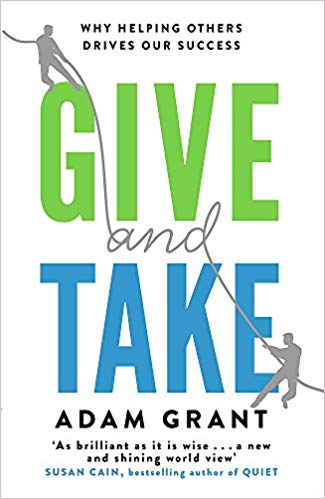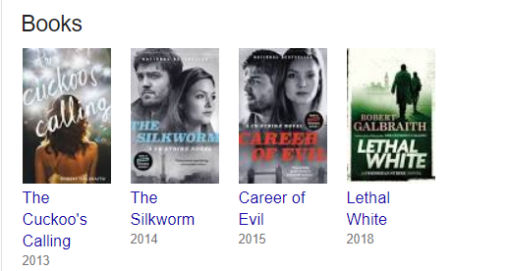Adam Grants’ Give and Take is truly a gem of a book. I was enamored by the content and insights, as well as the engaging writing style with anecdotes and stories galore. According to Adam Grant, people fall into three categories with respect to giving:
- Givers
- Matchers
- Takers
 Givers are those who give their time and other resources in order to help others without expecting anything in return. Takers focus more on taking things, favors from others without giving anything back. Matchers are those who are more transactional in nature. They always return their favors and expect the same from others. In case others do not reciprocate, matchers punish them – by avoiding them in future or by making sure that the takers’ reputation is spread.
Givers are those who give their time and other resources in order to help others without expecting anything in return. Takers focus more on taking things, favors from others without giving anything back. Matchers are those who are more transactional in nature. They always return their favors and expect the same from others. In case others do not reciprocate, matchers punish them – by avoiding them in future or by making sure that the takers’ reputation is spread.
I find the concept of “Giver” very appealing and inspiring. Giving is their first impulse and second nature. They make the pie bigger for everyone and pay forward. Adam Rifkin (fondly called Panda), through his five-minute-favor concept has become the most widely connected person, making a difference to a large number of people, both directly and indirectly. You can read about it here: Pay it forward.
Interestingly, givers are both at the top and bottom of the success ladder. It’s because there are two types of givers – selfless givers and otherish givers. Selfless givers succumb to giver burnout because they usually give without any discretion that saps away their energy and hinders their ability to prosper in their own endeavors. They engage in something called “sprinkling”, which means that the favors they do and help they provide are sprinkled throughout their day or week, as and when the requests come in. The otherish givers, on the other side, practice “chunking” where they set aside some time for giving and provide help only during those hours. This way, they are able to protect their energy and momentum on the activities that are important to them while also being able to provide meaningful support to others. Another way to address giver burnout is to see the impact of their giving. It greatly boosts their motivation to do more and reduce their burnout. Seeking help when needed is also another simple but rather underutilized strategy to combat burnout. 🙂
Giving benefits the giver in many ways – not only from the altruistic sense but also from the ripple effects. One interesting thing I learned from the book is that there is a magic number of hours that a person can perform volunteer work which provides the maximum benefit of giving without any adverse effects. And that is 100 hours per year.
Successful givers engage in certain common behaviors and strategies like below. Takers usually exhibit the opposite behavior.
- Be collaborative and give credit where it is deserved
- Create psychological safety
- Focus on collective good rather than individual gains
- Be a genius maker (multiplier) rather than a genius
- Believe in the potential of a person more than the current level of talent ( In order to be gain expertise we need to first develop interest in it and early teachers who encourage us and make the learning fun are invaluable. I never thought about it this way.)
- Engage in powerless communication
- Open to and seek advice
- Beware of and overcome responsibility bias (where one underestimates the contribution of others compared to yours in a group effort)
- Give energy and time due to a sense of enjoyment and purpose, rather than duty and obligation
Balancing powerful and powerless communication is challenging and needs certain level of emotional intelligence I would guess. I face many situations at work where powerful communication is expected, needed and rewarded. That said, I see several forms of powerless communication being engaged in as well. Specifically, asking questions, inserting hestitations, disclaimers, hedges etc., and rarely – asking advice. I think “asking advice” technique is so undervalued. I can see how it can be leveraged well, when used strategically. We can all ask more questions and more advice to sell more, to negotiate better etc. Even if it doesn’t come naturally to one, maybe due to cultural conditioning that “powerful communication” is always better, I think consciously adopting the powerless communication techniques will help us become more successful and actually better people.
So, intelligent giving is key. This quote by Herbert Simon says it all – “The intelligent altruists, though less altruist than the unintelligent altruists, will be fitter than both unintelligent altruists and selfish individuals.”
So, can people be truly altruistic or is all giving a form of selfishness? I believe that feeling good about doing good is not selfish and is actually altruism. Given that everything we do is driven by survival and positive experiences, it would be unnatural to define altruism as something we can do without even feeling satisfied or good about it.
I think I’m a matcher. Maybe because I’m very reserved and don’t really have a big network, and I don’t always really go about offering help at the outset. Having said that, when I’m asked for help, I seldom refuse, irrespective of whether I can get something in return. I think I come from “scarcity” rather than “abundance”, which prevents me from offering more without being asked. I definitely do not like to exploit others generosity.
Being a matcher, I think I find it easier and justified to shun takers when I realize they are just sapping my energy and time. I don’t really mind if I don’t get much or anything in return but self-absorbed people with their fakeness and consistent manipulation exude toxic vibes in my opinion, and leave unpleasant feelings in their wake.
There are loads of takeaways, strategies, and insights in this book. I found it interesting that the information on how much they are giving/contributing compared to their immediate circle/community, will make people to give more. The action items at the end of the book for an organization looking to create a more giving culture are a huge help. Here is the article about the same: 10 ways to get ahead through giving.
I’m impressed by the author and his work. I really liked the book. The major takeaway for me had been realizing the power of strategic giving, and understanding the difference between an otherish vs a selfless giver. Even in this competitive world, giving pays.
While having otherish strategies are important, it cannot be faked. Giving is a mindset and more a way of life, rather than a mere strategy or just behavioral. Let’s all be more giving, not because it benefits us, but because it benefits everyone. One byproduct of giving can be happiness and peace of mind. It’s less stressful to be open and helping than be calculative and mean.
In my experience, I’ve seen people who are more helpful receive more in terms of network. To a large extent, I believe that giving/taking is cultivated from the culture, surroundings, circumstances and a whole lot of external factors. By being in the presence of more positive and giving people, we can all can be better givers. Genes may be a factor, but the external factors can have at least 40 to 50% influence. We need more Adam Rifkins!





 This book by Gretchen Ruben has been a delightful read. It’s the author’s experiment on boosting her happiness by following a set of principles and making changes to her lifestyle over a period of 12 months. It’s definitely inspiring to hear her story but my initial reaction was one of overwhelmingness. Happiness really seemed a lot of work. Of course, one can’t expect to feel differently without changing anything in oneself and/or in the surrounding environment. Of course, happiness is a journey and not a goal and the author’s experience helped her to realize and understand what makes her happy, the knowledge and experience of which she can continue to use in future if she has to sustain or improve her happiness levels.
This book by Gretchen Ruben has been a delightful read. It’s the author’s experiment on boosting her happiness by following a set of principles and making changes to her lifestyle over a period of 12 months. It’s definitely inspiring to hear her story but my initial reaction was one of overwhelmingness. Happiness really seemed a lot of work. Of course, one can’t expect to feel differently without changing anything in oneself and/or in the surrounding environment. Of course, happiness is a journey and not a goal and the author’s experience helped her to realize and understand what makes her happy, the knowledge and experience of which she can continue to use in future if she has to sustain or improve her happiness levels.


